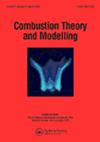Prediction of lower explosion limit of liquid fuel aerosol
IF 1.6
4区 工程技术
Q4 ENERGY & FUELS
引用次数: 0
Abstract
AbstractUnlike the explosion limit of liquid fuel vapour, the explosion limit of aerosol is a function of the aerosol state. In this study, a prediction model of the lower explosion limit (LEL) of liquid fuel aerosol was established through theoretical analysis, and typical liquid fuels of n-heptane and n-hexane were used to observe the aerosol state and the lower explosion concentration limits in the experiments to verify the reliability of the established model for predicting the LEL of aerosol. The predicted LELs of the two n-heptane aerosols (D32 = 12.16 µm) and (D32 = 21.23 µm) are 3.59 and 3.62 times of that of n-heptane vapour, respectively. The relative errors for the predictive results are 5.4% and 8.8%, respectively, compared with the experimental results. The predicted LEL of n-hexane aerosol (D32 = 18.51 µm) is 3.5 times that of n-hexane vapour, and the relative error is 3.99% compared with the experimental results.Keywords: Liquid fuelcombustible aerosolLELpredictive modelaerosol state AcknowledgementsThanks to Dr. Xueling Liu for participating in the experiments.Disclosure statementNo potential conflict of interest was reported by the author(s).Additional informationFundingThe research presented in this paper was supported by State Key Laboratory of Precision Blasting and Hubei Key Laboratory of Blasting Engineering, Jianghan University [grant number PBSKL2022A02].液体燃料气溶胶爆炸下限预测
摘要与液体燃料蒸气的爆炸极限一样,气溶胶的爆炸极限也是气溶胶状态的函数。本研究通过理论分析,建立了液体燃料气溶胶爆炸下限(LEL)的预测模型,并利用典型的正庚烷和正己烷液体燃料在实验中观察了气溶胶状态和爆炸下限浓度,验证了所建立的模型预测气溶胶LEL的可靠性。两种正庚烷气溶胶(D32 = 12.16µm)和(D32 = 21.23µm)的预测水平分别是正庚烷蒸汽的3.59和3.62倍。与实验结果相比,预测结果的相对误差分别为5.4%和8.8%。正己烷气溶胶(D32 = 18.51µm)的LEL预测值是正己烷蒸气的3.5倍,与实验结果的相对误差为3.99%。关键词:液体燃料可燃气溶胶预测模型气溶胶状态感谢刘雪玲博士参与实验。披露声明作者未报告潜在的利益冲突。本研究由江汉大学精密爆破国家重点实验室和爆破工程湖北省重点实验室资助[批准号:PBSKL2022A02]。
本文章由计算机程序翻译,如有差异,请以英文原文为准。
求助全文
约1分钟内获得全文
求助全文
来源期刊

Combustion Theory and Modelling
工程技术-工程:化工
CiteScore
3.00
自引率
7.70%
发文量
38
审稿时长
6 months
期刊介绍:
Combustion Theory and Modelling is a leading international journal devoted to the application of mathematical modelling, numerical simulation and experimental techniques to the study of combustion. Articles can cover a wide range of topics, such as: premixed laminar flames, laminar diffusion flames, turbulent combustion, fires, chemical kinetics, pollutant formation, microgravity, materials synthesis, chemical vapour deposition, catalysis, droplet and spray combustion, detonation dynamics, thermal explosions, ignition, energetic materials and propellants, burners and engine combustion. A diverse spectrum of mathematical methods may also be used, including large scale numerical simulation, hybrid computational schemes, front tracking, adaptive mesh refinement, optimized parallel computation, asymptotic methods and singular perturbation techniques, bifurcation theory, optimization methods, dynamical systems theory, cellular automata and discrete methods and probabilistic and statistical methods. Experimental studies that employ intrusive or nonintrusive diagnostics and are published in the Journal should be closely related to theoretical issues, by highlighting fundamental theoretical questions or by providing a sound basis for comparison with theory.
 求助内容:
求助内容: 应助结果提醒方式:
应助结果提醒方式:


